By Leen Randell
Updated: Jul 04, 2024
10 Best Herbal Decoctions For Stomach Pain
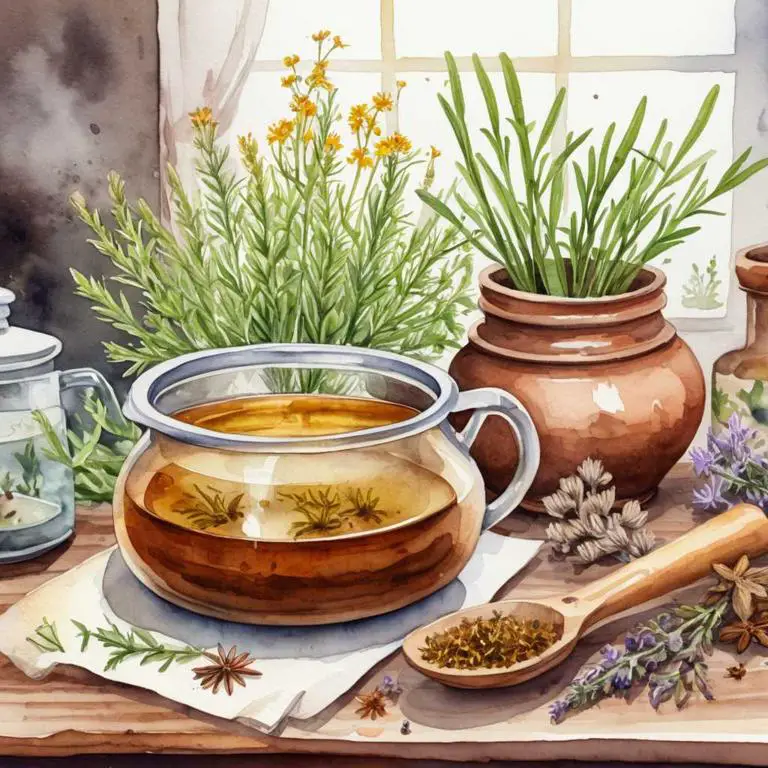
Herbal decoctions for stomach pain are a natural and effective way to alleviate digestive discomfort.
These concoctions involve steeping herbs in hot water to create a soothing liquid that can be consumed to ease symptoms such as bloating, cramps, and nausea. Examples of herbal decoctions that help with stomach pain include peppermint, ginger, and chamomile, which have anti-inflammatory properties that reduce inflammation in the digestive tract.
By using these decoctions, individuals can experience relief from stomach pain, allowing them to resume daily activities without discomfort and improving their overall quality of life.
The following article describes in detail the most important decoctions for stomach pain, including medicinal properties, parts of herbs to use, and recipes for preparations.
- 1. Glycyrrhiza glabra
- 2. Peperomia obtusifolia
- 3. Gaultheria procumbens
- 4. Taraxacum officinale
- 5. Aloe vera
- 6. Cinchona officinalis
- 7. Foeniculum vulgare
- 8. Zingiber officinale
- 9. Curcuma longa
- 10. Mentha x piperita
- What is the best combination of herbal decoctions to use for stomach pain?
- What ailments similar to stomach pain are treated with herbal decoctions?
1. Glycyrrhiza glabra
Licorice decoctions helps with stomach pain because they contain compounds that have anti-inflammatory properties, which can help reduce swelling in the digestive tract.
The glycyrrhizin present in licorice root has been shown to inhibit the production of prostaglandins, which are hormone-like substances that contribute to inflammation and pain in the stomach.
Additionally, the flavonoids and phenolic acids found in licorice decoctions have antioxidant properties, which can help protect the mucous membranes of the stomach from damage caused by digestive enzymes and other irritants.

Medicinal Constituents
The list below shows the primary medicinal constituents in Glycyrrhiza glabra decoctions that help with stomach pain.
- Licoricidin: This isoflavane acts as an anti-inflammatory agent, reducing inflammation in the stomach and alleviating pain.
- Glycyrrhizin: A triterpenoid saponin, glycyrrhizin has anti-ulcer properties and helps protect the stomach lining from acid damage, reducing pain and discomfort.
- Liquiritigenin: A flavanone, liquiritigenin has anti-inflammatory and antioxidant effects, which help reduce inflammation and oxidative stress in the stomach, thereby relieving pain and discomfort.
Parts Used
The list below shows the primary parts of licorice used to make decoctions for stomach pain.
- Roots: Roots are the most commonly used part for making decoctions to treat stomach pain because they contain the highest concentration of glycyrrhizin, a compound with anti-inflammatory properties.
- Roots: Roots are also used due to their ability to soothe the digestive system and reduce inflammation in the stomach.
- Roots: Additionally, roots are used to treat stomach pain because they have antispasmodic properties, which help to relax the muscles in the digestive tract and reduce cramping.
Quick Recipe
The following recipe gives a procedure to make a basic licorice for stomach pain.
- Harvest 30-60 grams of dried glycyrrhiza glabra roots for decoction.
- Grind the roots into a fine powder using a mortar and pestle.
- Combine the ground roots with 1 liter of water in a saucepan.
- Boil the mixture over medium heat for 10-15 minutes stirring occasionally.
- Strain the decoction through a cheesecloth or a fine-mesh sieve into a clean container.
2. Peperomia obtusifolia
Baby rubber plant decoctions helps with stomach pain because they possess anti-inflammatory properties that soothe digestive discomforts.
The plant's natural compounds, such as anthraquinones and flavonoids, have been traditionally used to calm colicky babies and alleviate symptoms of irritable bowel syndrome (IBS).
When consumed as a decoction, the herbal remedy helps to relax the stomach muscles, reduce inflammation, and ease cramping, providing relief from stomach pain and discomfort.
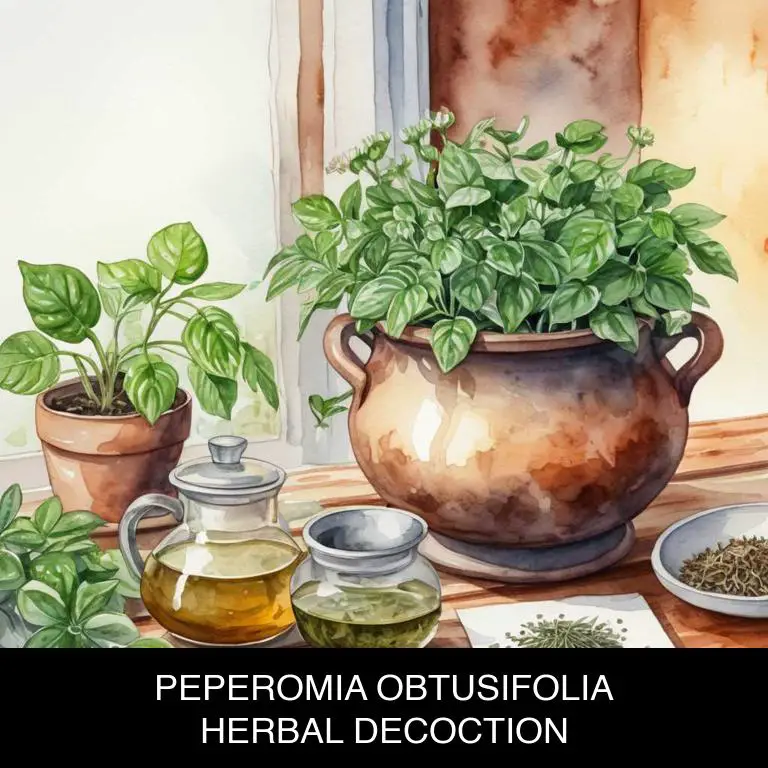
Medicinal Constituents
The list below shows the primary medicinal constituents in Peperomia obtusifolia decoctions that help with stomach pain.
- Phenolic acids: They have anti-inflammatory properties, which help to reduce inflammation in the stomach and alleviate pain.
- Alkaloids: These alkaloids have antispasmodic properties, which help to relax the smooth muscles in the stomach and reduce spasms that cause pain.
- Flavonoids: They have antioxidant properties, which help to protect the stomach lining from damage caused by free radicals and reduce inflammation that can lead to pain.
Parts Used
The list below shows the primary parts of baby rubber plant used to make decoctions for stomach pain.
- Leaves: They are used due to their anthelmintic and anti-inflammatory properties, which can help alleviate stomach pain and discomfort.
- Roots: They are used because of their analgesic and anti-inflammatory properties, which can help reduce pain and inflammation in the stomach.
- Stems: They are used due to their anti-inflammatory and antimicrobial properties, which can help soothe stomach irritation and reduce inflammation.
Quick Recipe
The following recipe gives a procedure to make a basic baby rubber plant for stomach pain.
- Harvest 20-30 fresh leaves of peperomia obtusifolia on a sunny morning after watering the plant thoroughly.
- Dry the harvested leaves in a warm oven at 150°f for 2 hours or until crispy.
- Grind 1 tablespoon of the dried leaves into fine powder using a mortar and pestle.
- Steep 1 teaspoon of the powdered leaves in 8 ounces of boiling water for 5-7 minutes.
- Strain the decoction through a coffee filter and drink 1-2 cups twice a day.
3. Gaultheria procumbens
Wintergreen decoctions helps with stomach pain because of its natural anti-inflammatory properties.
The compound methyl salicylate in wintergreen, similar to aspirin, helps to reduce inflammation in the digestive tract and ease discomfort. Additionally, wintergreen's soothing and calming effects can help to relax the muscles in the stomach and intestines, reducing spasms and cramps that often accompany stomach pain.
As a gentle and effective remedy, wintergreen decoctions offer natural relief from stomachache without harsh chemicals or medications.
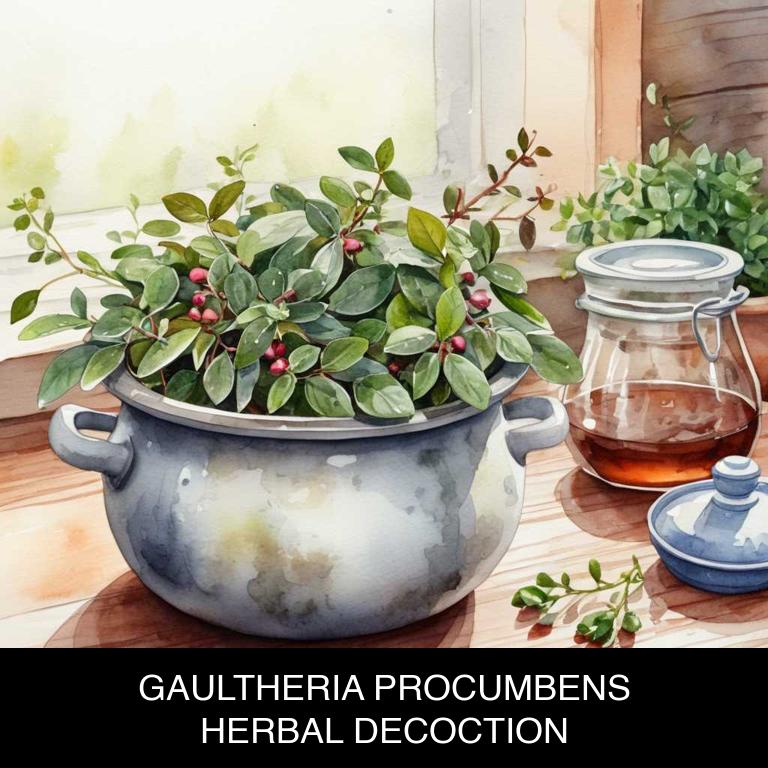
Medicinal Constituents
The list below shows the primary medicinal constituents in Gaultheria procumbens decoctions that help with stomach pain.
- Methyl salicylate: It acts as a natural pain reliever and anti-inflammatory agent, helping to reduce stomach pain and discomfort.
- Gaultherin: It has anti-inflammatory and antioxidant properties, which can help alleviate stomach pain and inflammation caused by digestive issues.
- Procumbene: It has been shown to have anti-inflammatory and analgesic properties, helping to reduce stomach pain and discomfort associated with digestive issues.
Parts Used
The list below shows the primary parts of wintergreen used to make decoctions for stomach pain.
- Roots: The roots of Gaultheria procumbens are primarily used because they contain a high concentration of glycosides, which are believed to possess anti-inflammatory properties that can help alleviate stomach pain.
- Leaves: Gaultheria procumbens leaves are used due to their high content of salicylic acid, a compound with analgesic and anti-inflammatory properties that can help soothe stomach discomfort.
- Stems: The stems of Gaultheria procumbens are used because they contain a mix of flavonoids and tannins that can help reduce inflammation and alleviate stomach pain.
Quick Recipe
The following recipe gives a procedure to make a basic wintergreen for stomach pain.
- Gather 1/4 cup of dried gaultheria procumbens leaves and roots from a reputable source.
- Combine the dried herb with 2 cups of water in a saucepan and bring to a boil.
- Reduce heat to a simmer and let it steep for 10-15 minutes to allow flavors to meld.
- Strain the decoction through a cheesecloth or a fine-mesh sieve into a clean container.
- Store the decoction in the refrigerator for up to 3 days or freeze for later use.
4. Taraxacum officinale
Dandelion decoctions helps with stomach pain because it soothes digestive issues by stimulating digestion, reducing inflammation, and acting as a natural antacid.
The diuretic properties of dandelion root help to flush out toxins and excess fluids from the body, which can alleviate symptoms of irritable bowel syndrome (IBS) such as bloating and discomfort.
Additionally, dandelion's anti-inflammatory compounds may help to reduce inflammation in the digestive tract, providing relief from stomach cramps and pain.

Medicinal Constituents
The list below shows the primary medicinal constituents in Taraxacum officinale decoctions that help with stomach pain.
- Saponins: Saponins in Taraxacum officinale decoctions help with stomach pain by reducing inflammation and protecting the mucous membranes in the stomach lining, thereby alleviating discomfort and pain.
- Flavonoids: Flavonoids in Taraxacum officinale decoctions have anti-inflammatory and antioxidant properties that help to soothe stomach pain and reduce inflammation in the digestive tract.
- Phenolic acids: Phenolic acids in Taraxacum officinale decoctions exhibit anti-inflammatory and antispasmodic properties, which help to relax the muscles in the stomach and alleviate cramps, spasms, and other types of stomach pain.
Parts Used
The list below shows the primary parts of dandelion used to make decoctions for stomach pain.
- Roots: Roots: The underground root system of Taraxacum officinale is used to make decoctions for stomach pain due to its ability to stimulate digestion and reduce inflammation.
- Leaves: Leaves: The leaves of Taraxacum officinale are used to make decoctions for stomach pain because they contain compounds that help to soothe and calm the digestive system.
- Flowers: Flowers: The flowers of Taraxacum officinale are used to make decoctions for stomach pain due to their anti-inflammatory properties and ability to reduce discomfort and pain in the digestive tract.
Quick Recipe
The following recipe gives a procedure to make a basic dandelion for stomach pain.
- Gather 50 to 100 grams of fresh taraxacum officinale leaves and flowers or 100 to 200 grams of dried material.
- Combine the taraxacum officinale material with 500 milliliters of cold water in a saucepan.
- Heat the taraxacum officinale mixture over low heat for 10 to 15 minutes or until it reaches a temperature of 80 to 90 degrees celsius.
- Allow the taraxacum officinale decoction to steep for 30 to 40 minutes then strain it using a cheesecloth or a fine-mesh sieve.
- Store the taraxacum officinale decoction in the refrigerator for up to 24 hours before consuming it.
5. Aloe vera
Aloe decoctions helps with stomach pain because of its anti-inflammatory and soothing properties.
The gel inside the aloe leaf contains compounds that reduce inflammation in the digestive tract, alleviating symptoms such as cramping, bloating, and discomfort. Additionally, aloe's natural emollient properties help to coat and calm the mucous membranes lining the stomach, promoting a healthy gut environment and easing digestive issues.
By reducing inflammation and soothing irritated tissues, herbal aloe decoctions provide effective relief from stomach pain and discomfort.

Medicinal Constituents
The list below shows the primary medicinal constituents in Aloe vera decoctions that help with stomach pain.
- Anthraquinones: These glycosidic compounds help reduce inflammation and relax muscles in the stomach, alleviating pain and discomfort caused by cramps and spasms.
- Phenolic acids: As antioxidants, these compounds help protect the stomach lining from oxidative stress, reducing inflammation and preventing damage to the stomach mucosa.
- Fatty acids: These compounds possess anti-inflammatory and soothing properties, which help calm the stomach and alleviate symptoms of pain, nausea, and indigestion.
Parts Used
The list below shows the primary parts of aloe used to make decoctions for stomach pain.
- Leaves: Aloe vera leaves are the most used part due to their high gel content, which has anti-inflammatory properties that help soothe stomach pain.
- Stems: Aloe vera stems, also known as the sap or latex, contain compounds that have analgesic and anti-inflammatory properties, making them effective in relieving stomach pain.
- Roots: Aloe vera roots are used to make decoctions that can help reduce inflammation and alleviate stomach pain due to their rich content of saponins and other bioactive compounds.
Quick Recipe
The following recipe gives a procedure to make a basic aloe for stomach pain.
- Harvest 20 to 30 grams of aloe vera leaves from mature plants at dawn for optimal potency.
- Clean the aloe vera leaves thoroughly under cold running water to remove dirt and debris.
- Chop the aloe vera leaves into small pieces and soak them in 1 liter of cold water for 2 hours.
- Boil the aloe vera-soaked water over medium heat for 10 to 15 minutes to activate the medicinal properties.
- Strain the decoction through a cheesecloth or a fine-mesh sieve into a clean container to remove solids.
6. Cinchona officinalis
Jesuit's bark decoctions helps with stomach pain because of its unique properties that target the root causes of digestive discomfort.
The decoction contains compounds like berberine, which has anti-inflammatory and antispasmodic effects, helping to reduce inflammation and relax muscles in the digestive tract. Additionally, Jesuit's bark has been shown to have antimicrobial properties, combating harmful bacteria and fungi that can contribute to stomach pain and discomfort.
This natural remedy has been used for centuries to provide relief from stomach pain and restore balance to the digestive system.
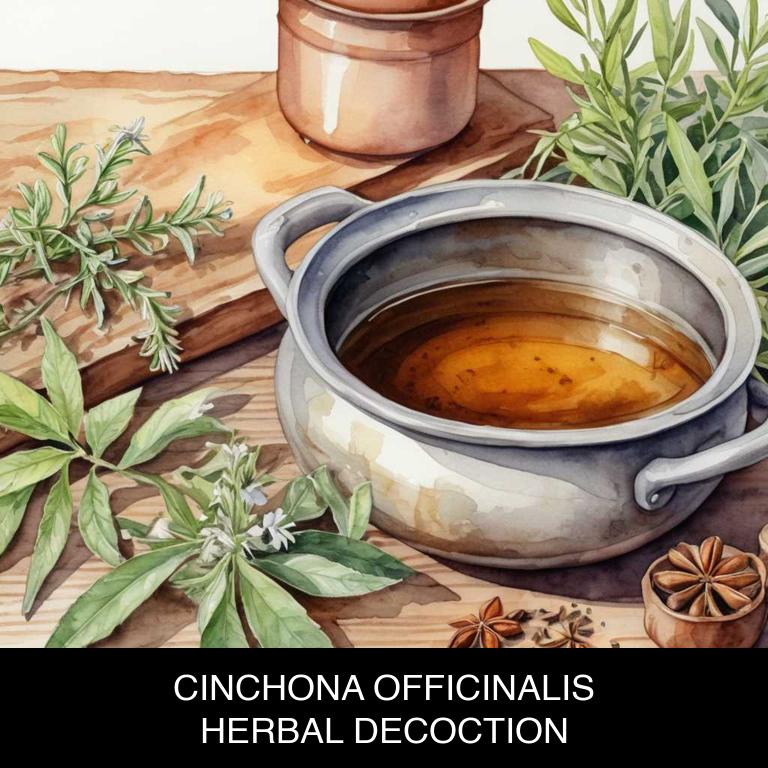
Medicinal Constituents
The list below shows the primary medicinal constituents in Cinchona officinalis decoctions that help with stomach pain.
- Quinine: Quinine helps alleviate stomach pain by reducing inflammation and modulating the release of neurotransmitters involved in pain perception.
- Cinchonine: Cinchonine contributes to the antispasmodic properties of Cinchona officinalis, helping to relax the smooth muscles in the gastrointestinal tract and alleviate cramps.
- Quinidine: Quinidine has a sedative effect on the smooth muscles, which can help to reduce spasms and ease stomach discomfort.
Parts Used
The list below shows the primary parts of jesuit's bark used to make decoctions for stomach pain.
- Leaves: The leaves of Cinchona officinalis are used to make decoctions for stomach pain due to their high concentration of quinine, which has anti-inflammatory properties that help soothe stomach discomfort.
- Barks: The barks of Cinchona officinalis are used to make decoctions for stomach pain due to their high concentration of alkaloids, including quinine, which helps to reduce inflammation and alleviate stomach cramps.
- Seeds: The seeds of Cinchona officinalis are used to make decoctions for stomach pain due to their ability to stimulate digestion and relieve nausea, helping to alleviate stomach discomfort and pain.
Quick Recipe
The following recipe gives a procedure to make a basic jesuit's bark for stomach pain.
- Gather 2-3 grams of dried cinchona officinalis bark and 1 liter of distilled water for decoction.
- Chop the cinchona bark into small pieces to increase its surface area for infusion.
- Combine the chopped cinchona bark with 1 liter of boiling water in a large saucepan.
- Steep the cinchona bark mixture for 10-15 minutes to release its bioactive compounds.
- Strain the decoction through a cheesecloth or fine-mesh sieve into a clean container.
7. Foeniculum vulgare
Fennel decoctions helps with stomach pain because it soothes the digestive system by relaxing the muscles in the stomach and intestines, reducing cramping and spasms.
The carminative properties of fennel also help to eliminate gas and bloating, alleviating discomfort and pressure in the abdomen. Additionally, fennel's anti-inflammatory compounds may reduce inflammation in the gut, which can contribute to chronic pain and discomfort.
By promoting a healthy balance in the digestive system, fennel decoctions provide natural relief from stomach pain.
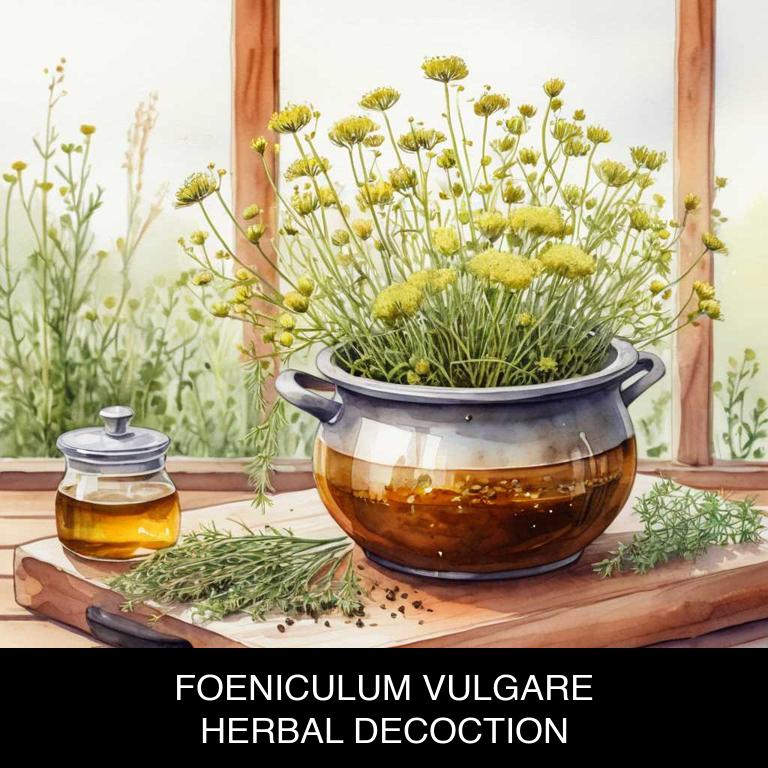
Medicinal Constituents
The list below shows the primary medicinal constituents in Foeniculum vulgare decoctions that help with stomach pain.
- Anethole: Anethole, a terpene compound, helps to reduce stomach pain by relaxing smooth muscle in the digestive tract and reducing inflammation.
- Foeniculin: Foeniculin, a phenolic compound, exerts anti-inflammatory effects, which can help alleviate stomach pain and discomfort associated with inflammation in the digestive tract.
- Furfural: Furfural, an aldehyde compound, has been shown to have anti-inflammatory and antioxidant properties, which can help reduce stomach pain and inflammation caused by oxidative stress in the digestive system.
Parts Used
The list below shows the primary parts of fennel used to make decoctions for stomach pain.
- Seeds: The seeds of Foeniculum vulgare are commonly used in decoctions for stomach pain due to their carminative properties, which help to relieve gas and digestive discomfort.
- Leaves: The leaves of Foeniculum vulgare are used in decoctions for stomach pain because they contain compounds that have anti-inflammatory and antispasmodic effects, helping to soothe digestive issues.
- Barks: The bark of Foeniculum vulgare is used in decoctions for stomach pain due to its astringent properties, which help to reduce inflammation and alleviate digestive discomfort.
Quick Recipe
The following recipe gives a procedure to make a basic fennel for stomach pain.
- Harvest approximately 50g of foeniculum vulgare leaves and stems from a clean and organic source.
- Chop the harvested foeniculum vulgare into smaller pieces to increase surface area and facilitate infusion.
- Combine the chopped foeniculum vulgare with 250ml of boiling water in a heat-resistant glass or ceramic container.
- Steep the foeniculum vulgare and water mixture for 10-15 minutes to allow for maximum extraction of active compounds.
- Strain the decoction through a cheesecloth or fine-mesh sieve into a clean container and discard the solids.
8. Zingiber officinale
Ginger decoctions helps with stomach pain because it stimulates digestion, reducing inflammation and spasms in the digestive tract.
The bioactive compounds in ginger, such as gingerol and shogaol, have natural anti-inflammatory properties that soothe the stomach lining and relax muscles, alleviating cramps, bloating, and discomfort.
Additionally, ginger's carminative effects help to release trapped gas and ease nausea, providing rapid relief from stomach pain caused by indigestion, food poisoning, or irritable bowel syndrome.

Medicinal Constituents
The list below shows the primary medicinal constituents in Zingiber officinale decoctions that help with stomach pain.
- Gingerol: A type of phenolic compound, gingerol helps reduce inflammation and relax the muscles in the stomach, providing relief from stomach pain and discomfort.
- Shogaol: A bioactive compound similar to gingerol, shogaol has anti-inflammatory properties that help alleviate stomach pain and nausea by reducing inflammation and improving digestion.
- 6-gingerol: A phenolic compound with potent anti-inflammatory and antioxidant properties, 6-gingerol helps reduce inflammation in the stomach, alleviate pain, and promote healing, ultimately providing relief from stomach discomfort.
Parts Used
The list below shows the primary parts of ginger used to make decoctions for stomach pain.
- Roots: The underground part of the plant, which is used to make decoctions for stomach pain because it contains compounds like gingerol and shogaol that have analgesic and anti-inflammatory effects.
- Buds: The young, unopened flower stalks of the plant, which are used to make decoctions for stomach pain due to their high content of bioactive compounds that aid in digestion and reduce inflammation.
Quick Recipe
The following recipe gives a procedure to make a basic ginger for stomach pain.
- Gather 1-2 teaspoons of dried zingiber officinale root and store it in a cool dry place for future use.
- Boil 1 quart of water in a pot for 5-10 minutes to create a hot decoction base.
- Add the dried zingiber officinale root to the boiling water and reduce heat to a simmer for 5-10 minutes.
- Strain the decoction through a cheesecloth or a fine-mesh sieve to remove the root particles and sediment.
- Store the herbal decoction in a glass container in the refrigerator for up to 3 days.
9. Curcuma longa
Turmeric decoctions helps with stomach pain because of its anti-inflammatory and antioxidant properties.
The bioactive compound curcumin in turmeric decoctions reduces inflammation in the digestive tract, alleviating symptoms of irritable bowel syndrome (IBS), such as cramping, bloating, and diarrhea. Additionally, turmeric's natural antimicrobial agents help eliminate harmful bacteria and fungi that can cause stomach pain and discomfort.
By promoting healthy gut flora and reducing oxidative stress, turmeric decoctions provide a natural solution for soothing stomachaches and promoting overall digestive well-being.
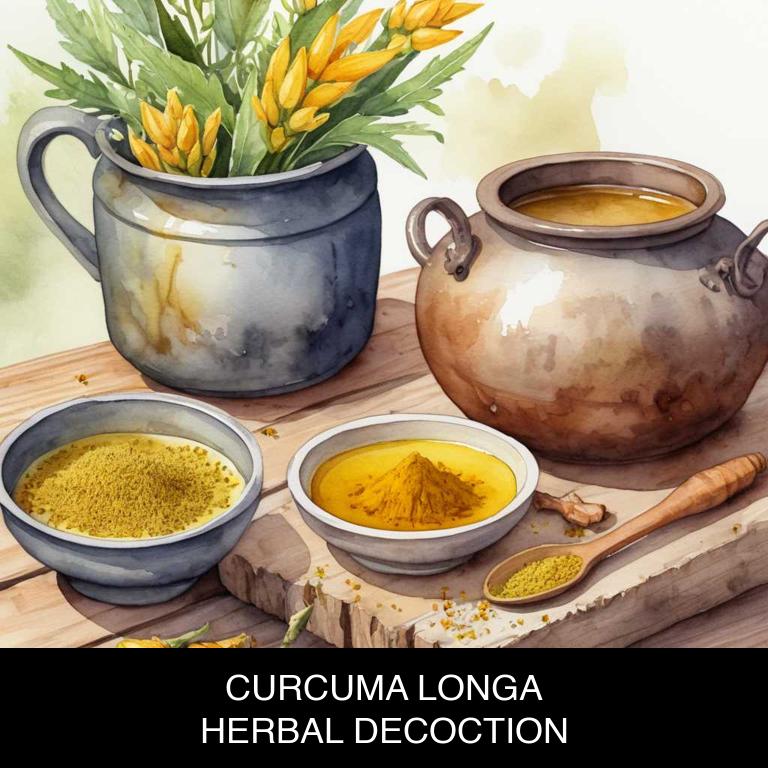
Medicinal Constituents
The list below shows the primary medicinal constituents in Curcuma longa decoctions that help with stomach pain.
- Curcumin: A polyphenolic compound that helps with stomach pain by inhibiting the production of pro-inflammatory enzymes, thereby reducing inflammation and alleviating pain in the digestive tract.
- Demethoxycurcumin: A bioactive compound that exhibits anti-inflammatory and antioxidant properties, helping to soothe and calm the stomach lining, reducing inflammation, and alleviating pain.
- Turmerone: A sesquiterpene that has anti-inflammatory and analgesic properties, helping to reduce pain and inflammation in the stomach, and promoting a speedy recovery from stomach-related ailments.
Parts Used
The list below shows the primary parts of turmeric used to make decoctions for stomach pain.
- Roots: Roots: The roots of the Curcuma longa plant contain a significant amount of curcumin, making them a popular choice for decoctions that aim to soothe stomach discomfort.
- Leaves: Leaves: Although the leaves contain less curcumin than the rhyzome or roots, they are still used in some decoctions due to their anti-inflammatory properties, which can help reduce stomach pain and inflammation.
Quick Recipe
The following recipe gives a procedure to make a basic turmeric for stomach pain.
- Chop 3-5 grams of dried curcuma longa rhizomes into small pieces to release their active compounds.
- Combine the chopped rhizomes with 250 milliliters of water in a saucepan and bring to a boil.
- Reduce the heat to a simmer and let the mixture steep for 10-15 minutes to allow extraction.
- Strain the decoction through a fine-mesh sieve into a clean container to remove solids.
- Store the filtered decoction in the refrigerator and consume within 24 hours for optimal potency.
10. Mentha x piperita
Peppermint decoctions helps with stomach pain because it has a natural soothing effect on the digestive system.
The menthol present in peppermint relaxes the muscles in the stomach, reducing spasms and cramping that can cause discomfort and pain. Additionally, peppermint's anti-inflammatory properties help reduce inflammation in the digestive tract, which can contribute to stomach pain.
By calming the stomach and reducing inflammation, peppermint decoctions provide effective relief from stomach pain, allowing for a more comfortable digestive experience.

Medicinal Constituents
The list below shows the primary medicinal constituents in Mentha x piperita decoctions that help with stomach pain.
- Menthol: Acts as a local anesthetic to numb the stomach lining and reduce pain perception.
- L-menthone: Exhibits anti-inflammatory properties to reduce inflammation and discomfort in the stomach, thereby alleviating pain.
- Rosmarinic acid: Possesses antioxidant properties to neutralize free radicals and protect the stomach lining from damage, thereby reducing pain and inflammation.
Parts Used
The list below shows the primary parts of peppermint used to make decoctions for stomach pain.
- Leaves: They contain menthol and other volatile oils that help to relax the digestive system and reduce inflammation.
- Roots: The roots have a higher concentration of menthol and other compounds that aid in soothing stomach pain and reducing nausea.
- Stems: The stems also contain menthol and other oils that help to calm the digestive system and relieve stomach discomfort.
Quick Recipe
The following recipe gives a procedure to make a basic peppermint for stomach pain.
- Harvest 20-30 grams of fresh mentha x piperita leaves and flowers for decoction preparation.
- Chop the harvested mentha x piperita leaves and flowers into small pieces for infusion.
- Combine the chopped mentha x piperita with 500 milliliters of boiling water in a saucepan.
- Boil the mixture for 5-7 minutes or until the liquid reduces slightly and the flavor is intense.
- Strain the decoction using a cheesecloth or a fine-mesh sieve into a clean container.
What is the best combination of herbal decoctions to use for stomach pain?
The best combination of herbal decoctions that help with stomach pain is a blend of peppermint, ginger, and licorice root.
Peppermint soothes the digestive tract, reducing inflammation and calming the stomach. Ginger's anti-inflammatory properties aid in digestion and alleviate nausea.
Licorice root provides a protective barrier to the stomach lining, preventing acid damage. Together, these decoctions create a harmonious balance, promoting relaxation and natural healing of stomach issues.
This combination can be prepared as a tea or infused in warm water for optimal relief.
What ailments similar to stomach pain are treated with herbal decoctions?
Ailments similar to stomach pain that are treated with herbal decoctions are constipation, diarrhea, dysentery, and urinary tract infections.
Decoctions made from herbs such as Senna, Cascara sagrada, and Rhubarb help stimulate bowel movements, while those containing herbs like Goldenseal, Uva ursi, and Marshmallow root may be used to alleviate digestive discomfort and soothe the mucous membranes of the gut and urinary tract.